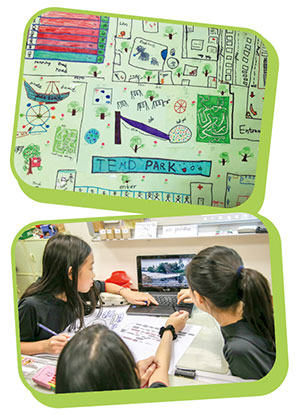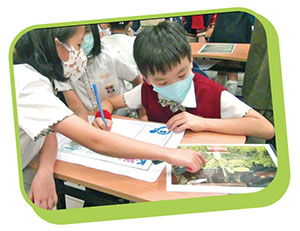
Taking Action & Making a Difference
國際處主任 賴國宜
Involving children to work on authentic problems for the community is an important part of our English projects. It connects what is being taught in the classrooms to the students' surroundings. After being presented with a real-life problem, students apply what they are studying in the curriculum to analyze and research the problem and then provide an action plan to solve it. Through this process, they develop a deeper understanding of the subject matter and experience how children like them work together to make a difference in the community. Mr. Claassen's article provides some examples of how we integrate community learning with our English projects.
To promote our students' presentation skills, we organized annual interclass competitions for Grades 1 to 6. This year we had a new debate competition in which our Grade 6 students were challenged to use their logical thinking and argumentation skills. We really appreciate all the contestants' hard work to perform their best on stage.
從學習者的角度思考,培養未來的社會和世界公民,是108課綱的核心教育理念。康橋的英文專題課程以主題探究的方式,讓學生關注校園、社區以至全球議題。他們運用課堂所學的知識與技能,研究生活周遭的問題,例如:校園空間運用、塑膠汙染、缺水問題等。這樣的學習歷程中,孩子們關心並主動參與公共議題,擴大視野,跳脫課本固定範圍,感受到自己的力量,能為更美好的未來做出正向的改變。本期邀請國際處副主任Roland Claassen說明我們如何將社區議題融入英文專題課程。
今年的英語班際競賽如期在第三、四週舉行,但為了避免群聚,無法安排全學年觀摩決賽,我們剪輯了決賽過程的花絮,還有前三名得獎者的精彩表演,於英文課中跟孩子們分享。不論得獎與否,相信在準備與參賽的過程中,小組團隊的合作與配合是孩子們最好也是最難忘的學習經驗。
天氣逐漸溫暖,春光明媚,令人神清氣爽,正是讀書的好季節,收起電腦和手機,和孩子來個春天的約會,一起讀幾本好書或是攜手戶外踏青,享受美好的親子時光,祝福您和孩子闔家幸福。

~ Roland Claassen
Assistant Director of the International Department
Discovering Community Learning
Sometimes as educators it can be challenging to get students excited about learning and acquiring new skills. One important component of our English curriculum is community learning in which students embark on different projects that take them beyond the four walls of the classroom. This teaching methodology promotes learning through active participation in meaningful service experiences in the community that are directly related to course content. It teaches skills like critical thinking, decision-making, and problem solving, and it pushes students to think about the content from a “big picture” perspective.
Integrating Community Learning

What does community learning look like in practice? There are many ways we integrate community learning into our English curriculum, depending on the learning goals, the size of the class, the academic preparation of the students, and the community partnership or project type. Typically, community learning is incorporated into our curriculum by way of an inquiry-based English project that has both learning and community action goals. The project asks students to apply course content to community-based activities.
Our fourth grade students complete a project in which they learn about the important features of a community park and what the government or local neighborhood needs to consider when developing a park for its citizens. Students first determine the specific demographic of the community that will utilize the park and then design it based on the interests and needs of those visitors. If the park they would like to develop is for the elderly, they need to be more conscious of features in a park most applicable to senior citizens.
Another wonderful project that focuses on the environment is our sixth grade project in which students learn about the global water shortage problem. From a reading in their textbooks, students learn about the various causes and effects of water shortage. After extended research about various locations that suffer from water shortage, students are tasked to call for immediate attention by raising the awareness of local citizens.

By connecting our projects to the community, we give students experiential opportunities to learn in real-world contexts and develop skills of community engagement. But community learning shouldn’t be limited to older students. Younger children are also excited to get involved. They are so curious about the world around them and they are eager to help where possible. After reading A Walk in the Desert, an informational text about the biomes in North America, second grade students were asked to create informative plaques for various flora found within our nature study area. These signs will inform visitors and other students about the unique plants we have right here on campus.
Nurturing Global Citizens
Although it may require a lot of time and effort, the benefits of community learning can be rewarding. Community learning creates an environment where students face the problems that real communities are facing. By doing this, they become more engaged in their own learning process. If we want children to be problem solvers, we need to give them real-life problems to solve. Taking action and helping the community will make our students be more proactive in the future and become better global citizens. The main benefit of community learning is simple: It makes learning authentic and meaningful.
Education is for improving the lives of others and for leaving
your community and world better than you found it.
-Marian Wright Edelman

![]() 全文下載)
全文下載)